The Top 10 Mistakes CEOs Make on LinkedIn

Chapter 1: The Importance of LinkedIn for Executives
Why LinkedIn Matters
LinkedIn is an indispensable tool for CEOs seeking to establish themselves as thought leaders. By sharing insights and expertise, executives can position themselves as knowledge authorities in their respective fields. This not only enhances their personal brand but also significantly benefits their companies. When a CEO is recognized as a thought leader, it elevates the entire organization’s credibility, fostering trust and admiration among peers, clients, and industry stakeholders. This visibility can translate into speaking engagements, media opportunities, and a stronger presence in industry conversations, all of which contribute to a robust and influential personal brand.
Beyond personal branding, LinkedIn plays a critical role in business development. The platform’s vast network of professionals offers CEOs unparalleled access to potential hires, partners, investors, and customers. Effective use of LinkedIn can streamline the hiring process, making it easier to attract and retain top talent who are inspired by the CEO’s vision and leadership. Additionally, visibility on LinkedIn can facilitate fundraising efforts by showcasing the company’s milestones and strategic direction to potential investors. For customer acquisition, a well-maintained LinkedIn presence can draw in new clients who are engaged by the CEO’s thought leadership and the company’s innovative solutions.
One of the most significant advantages of LinkedIn over traditional public relations efforts is the ability to engage in ongoing, two-way interactions. Traditional PR methods, such as speaking at conferences or being featured in publications, are typically one-time events with limited opportunities for direct engagement. In contrast, LinkedIn allows for continuous dialogue with a professional audience. CEOs can receive immediate feedback on their posts, engage in discussions, and build relationships through comments and direct messages. This ongoing engagement is not only more dynamic but also measurable. LinkedIn provides analytics and data that help executives understand what content resonates with their audience, enabling them to refine their strategies and maximize their impact.
Key takeaways:
- Thought Leadership: Establishing yourself as a knowledge authority benefits your company and enhances your personal brand.
- Business Development: Easier hiring, retention, fundraising, and customer acquisition.
- Ongoing Engagement: Unlike traditional PR, LinkedIn offers continuous, two-way interaction with metrics to measure success.
Benefits of LinkedIn Over Traditional PR
LinkedIn offers a significant advantage over traditional public relations by enabling ongoing relationships rather than one-time exposure. Traditional PR efforts, such as speaking engagements at conferences or features in publications, provide a fleeting moment of visibility. If the target audience misses the event or publication, the opportunity for engagement is lost. In contrast, LinkedIn allows executives to maintain a continuous presence and build lasting relationships with their audience. Through regular posts and updates, executives can keep their followers engaged, ensuring that their message remains relevant and top-of-mind.
Another critical advantage of LinkedIn is the facilitation of two-way dialogue. Traditional PR methods often involve a one-way communication model, where the executive speaks to an audience with little to no immediate feedback. This lack of interaction can limit the impact and effectiveness of the message. LinkedIn, however, encourages feedback and interaction through comments, likes, and shares. This two-way dialogue not only fosters a sense of community but also allows executives to gain valuable insights from their audience. By engaging directly with their followers, executives can address questions, respond to comments, and build a more personal and interactive relationship with their network.
LinkedIn also excels in providing robust data analytics, offering insights into what content works and what doesn’t. Traditional PR lacks the ability to measure the effectiveness of a message accurately. Metrics for speaking engagements or magazine features are often limited to indirect indicators like audience size or publication circulation. In contrast, LinkedIn provides detailed analytics on post performance, including views, likes, shares, and comments. This data allows executives to refine their content strategy based on what resonates most with their audience. By leveraging these insights, executives can optimize their LinkedIn presence, ensuring that their content is both engaging and effective.
In conclusion, LinkedIn surpasses traditional PR in several key areas: it enables ongoing relationships through continuous engagement, fosters two-way dialogue for better interaction and feedback, and provides comprehensive data analytics to measure and improve content effectiveness. These advantages make LinkedIn an essential tool for executives looking to enhance their visibility, engage with their audience, and establish themselves as thought leaders in their industry.
Key takeaways:
- Ongoing Relationship: Enables continuous interaction rather than one-time exposure.
- Two-Way Dialogue: Encourages feedback and interaction.
- Data Analytics: Provides insights into what content works and what doesn’t.
Chapter 2: Common Mistakes and How to Avoid Them
1. Focusing Too Much on the Company Page
The number one mistake CEOs make on LinkedIn is focusing too much on their company page rather than their personal profiles. While having a company page is essential, relying solely on it can be a missed opportunity for engagement and visibility. Personal posts from a human being tend to receive much more attention and interaction than posts from a faceless organization. This is because LinkedIn's algorithm and users both favor content that comes from individuals, which feels more personal and relatable. The essence of LinkedIn has shifted from a business-to-business platform to a human-to-human network, emphasizing the importance of executives representing their companies through their personal presence. By doing so, they can personalize their brand and foster stronger connections with their audience.
Key Takeaways:
- Issue: Company pages get less visibility compared to personal posts.
- Solution: Personalize the brand through executives’ profiles.
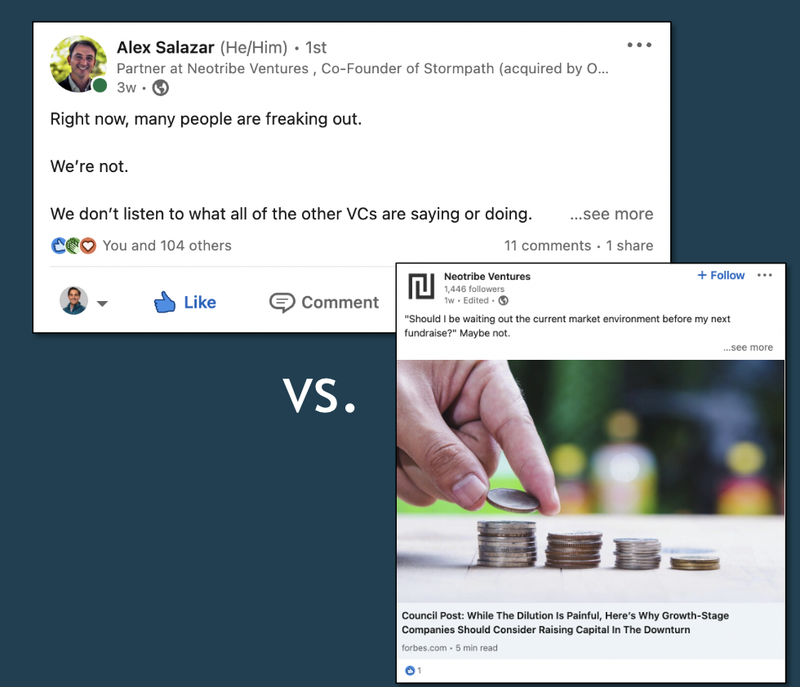
2. Infrequent Posting
The second major mistake that executives make on LinkedIn is not posting frequently enough. Many CEOs and top executives post only two to three times a year, usually around significant milestones such as raising a large funding round, making a senior hire, or being featured in a major publication like Forbes. While these posts often perform well, they are not sufficient to maintain visibility and stay top of mind. LinkedIn is a platform where daily relevance is crucial, and posting just a few times a year does not achieve that.
Data analysis of LinkedIn's top voices reveals that these prominent figures post an average of 5.2 times per week, with some even posting two to three times a day. While posting that frequently may not be necessary for everyone, a minimum of two to three times per week is essential, with five times a week being ideal. Establishing a routine, as emphasized in the book "Atomic Habits," can help maintain consistency in posting. Regularly appearing in the feed helps train your audience to expect and engage with your content.
Executives often worry that posting frequently will overwhelm their audience. However, LinkedIn's algorithm shows content to only a small fraction of your followers—about 10%. This means that even with frequent posts, only a subset of your audience will see each one. Therefore, it's important to post regularly to ensure your content reaches different segments of your audience and keeps you relevant in their minds.
Everyone is “honored” or “humbled” on LinkedIn… be original.
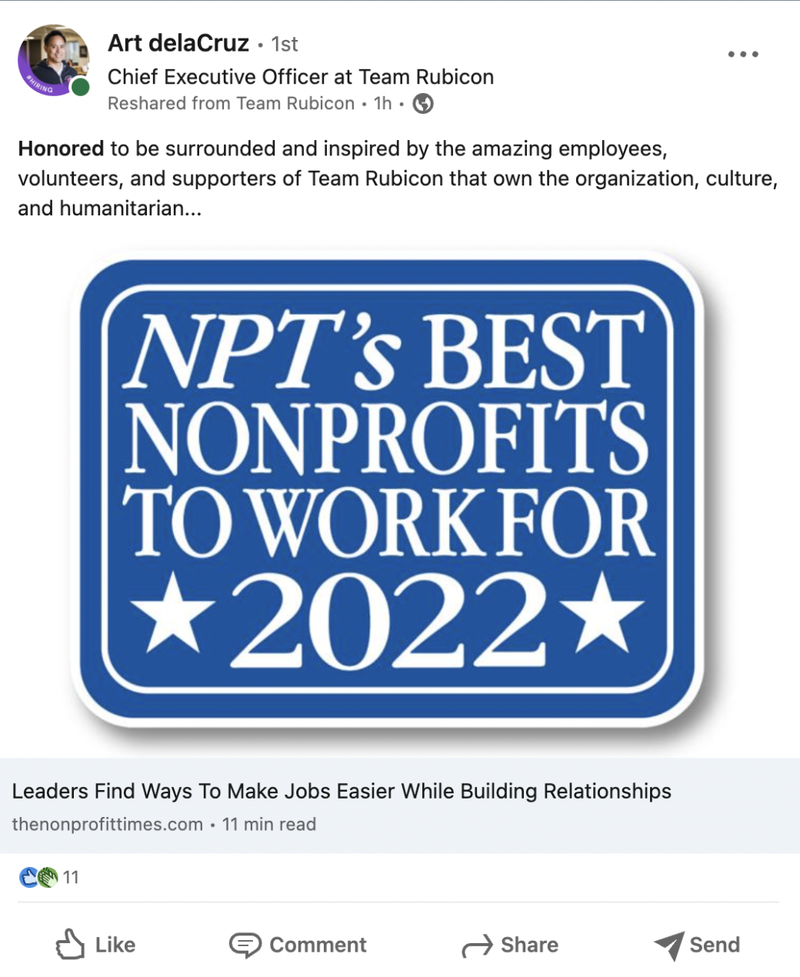
Key Takeaways:
- Issue: Posting only during major milestones (2-3 times per year) is not enough.
- Solution: Aim for 2-5 posts per week to maintain relevance and engagement.
3. Over-Promoting the Company
A common mistake that executives make on LinkedIn is using their personal profiles merely to promote their companies. This approach can make their presence feel like a mouthpiece for corporate propaganda, leading to a lack of genuine engagement. Typically, this happens when the social media manager responsible for the company's page is also tasked with managing the executive's personal page, resulting in repetitive, company-centric posts. While it's acceptable to occasionally post about company news, this shouldn't dominate the content.
Instead, executives should follow the 80-10-10 rule for their content strategy. This means 80% of posts should be educational, providing value to the audience without any direct mention of the company. For example, if the company is involved in cryptocurrency, the posts should educate about cryptocurrency in general. Another 10% of posts should be personal stories that humanize the executive, such as sharing origin stories, lessons learned, or personal interests tied back to business. The final 10% can be promotional, including updates about webinars, new hires, or other company-related news. This balanced approach ensures the content is valuable and engaging, helping to build trust and a larger following.
Moreover, incorporating vulnerability into posts can significantly enhance trust and engagement. While sharing major successes is important, being open about mistakes and failures can resonate more deeply with the audience. It shows authenticity and relatability, which are crucial for building meaningful connections on LinkedIn. By avoiding the pitfalls of constant self-promotion and embracing a more balanced and personal content strategy, executives can foster a more engaged and loyal audience.
Examples of LinkedIn posts that are overly promotional of one’s company.

Key Takeaways:
- Issue: Posting only about the company can seem like propaganda.
- Solution: Use the 80-10-10 Rule:
- 80% Educational content
- 10% Personal stories
- 10% Company promotion
4. Not Writing for LinkedIn
One major mistake that many CEOs make on LinkedIn is not writing content specifically tailored for the platform. To be effective on LinkedIn, posts must capture attention immediately. This involves creating compelling, attention-grabbing first lines that encourage readers to click the "See More" button. The LinkedIn algorithm rewards posts that generate quick engagement, indicating that capturing the audience's attention from the start is crucial. For example, using surprising statistics, thought-provoking statements, or cliffhangers can effectively arrest the feed and prompt users to read further.
Additionally, writing for LinkedIn means making your posts skimmable. Given that users often scroll quickly through their feeds, using short sentences, bullet points, and easy-to-read formats can significantly improve engagement. The phrase "If I had more time, I would have written a shorter letter" underscores the importance of brevity and clarity. Thoughtful, concise posts are often more appreciated and shared. However, there's a growing fatigue with the "broetry" format—one-sentence lines stacked on top of each other—which suggests a need for variety in how content is presented.
Moreover, effective LinkedIn content often includes polarizing or contrarian viewpoints. Statements that challenge common beliefs or present strong opinions can spark conversations and drive higher engagement. Personal stories, lists, and polarizing statements all perform well on LinkedIn, as they invite readers to think, react, and engage. Embracing controversy and standing out with unique perspectives can be highly beneficial, helping to build a stronger personal brand and fostering deeper connections with your audience.
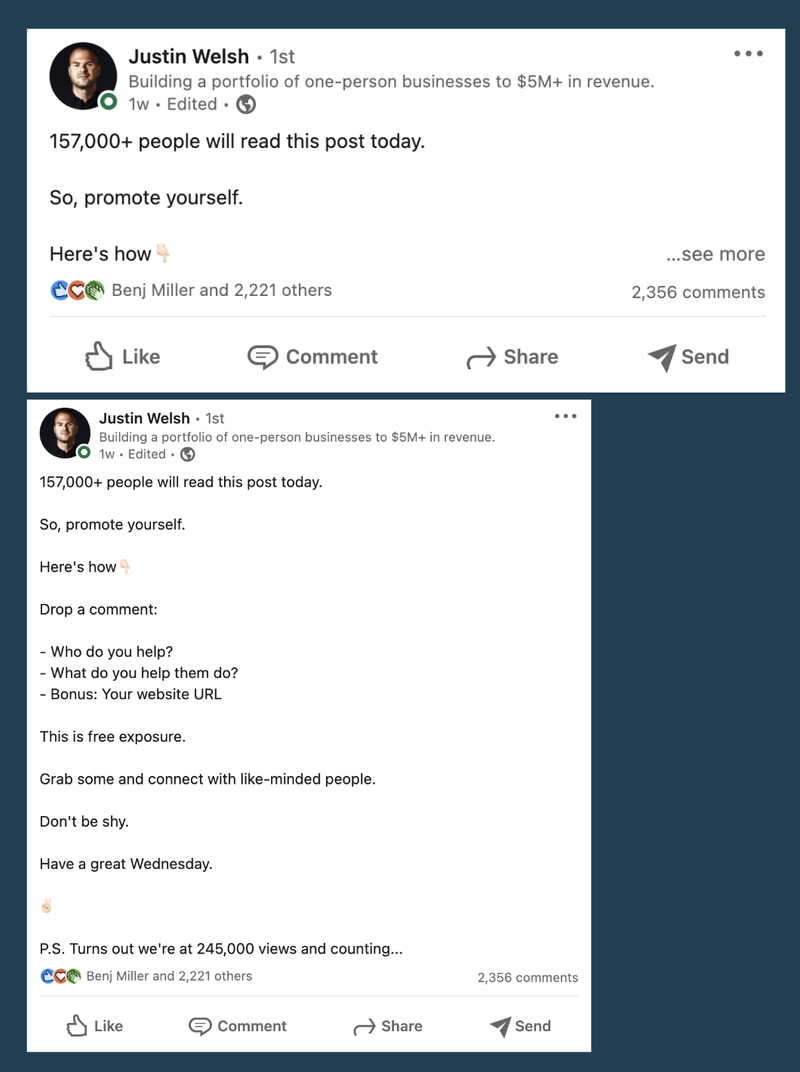
Example #1 of a well-written LinkedIn post: (1) solid hook, (2) skimmable, (3) clear takeaway at the end.

Example 2: of a well-written LInkedIn post: succinct, with a good hook.
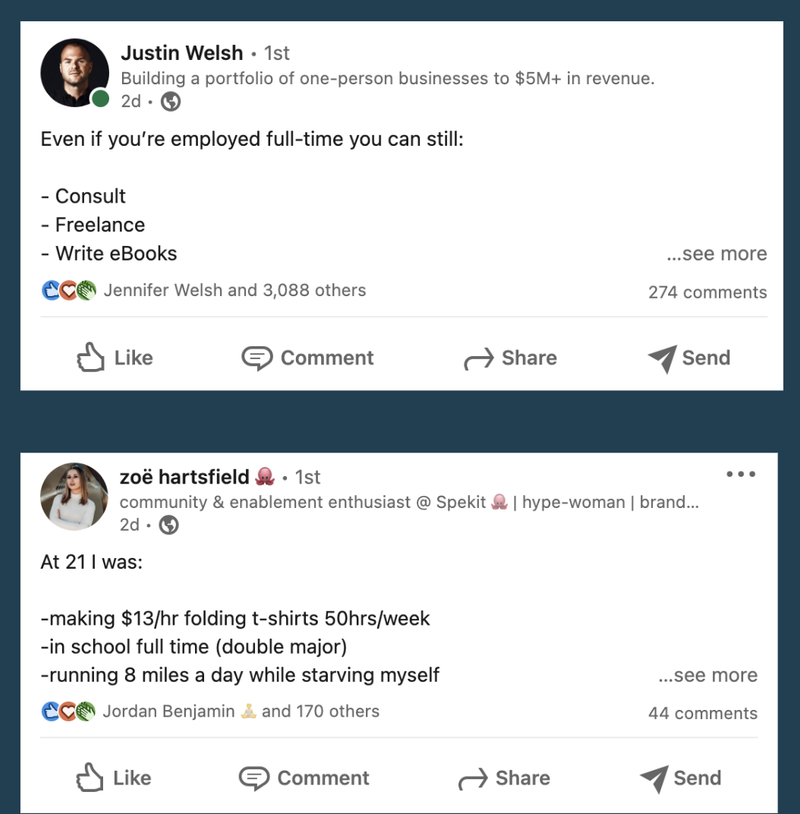
Example #3 of good LinkedIn posts, these one’s making excellent use of a list.
Key Takeaways:
- Issue: Long, dense paragraphs are hard to read.
- Solution: Use skimmable formats, compelling first lines, and engaging storytelling.
5. Posting Late in the Day
A common mistake executives make on LinkedIn is posting late in the day, which often indicates a lack of strategic planning. Typically, these posts emerge from spontaneous ideas at the end of the workday, such as at 5 PM on a Friday. While there's some room for experimentation with posting times, it's generally more effective to post early in the morning. This strategy ensures that your content "lives" as long as possible throughout the day, maximizing its visibility and engagement.
Most people are more active on LinkedIn earlier in the day, before they get immersed in their evening routines with Netflix, Amazon Prime, or Hulu. Therefore, posting in the morning aligns with higher activity levels, increasing the chances that your content will be seen and interacted with. It’s recommended to post at a consistent time, ideally around 7 or 8 AM local time, depending on where your audience is primarily located. Consistency helps train your audience to expect your content at a certain time, which can further enhance engagement.
Given that LinkedIn posts have a lifespan of about 8 to 24 hours, ensuring that your post is visible during peak activity times is crucial. By posting early, you give your content the best chance to be seen by the largest number of people throughout the day, thereby maximizing its impact and reach.
Key Takeaways:
- Issue: Posts made late in the day have less visibility.
- Solution: Post early in the morning to maximize exposure.
6. Not Responding to Comments
One significant mistake that CEOs make on LinkedIn is not responding to comments. This issue is particularly evident among executives at larger companies. Instead of simply acknowledging comments with a "thanks," a more effective approach is to engage deeply with the comment, showing that you have read and understood it. For instance, responding with thoughtful insights or additional information related to the comment can spark further conversation and engagement.
Comment exchanges on LinkedIn are believed to have an algorithmic boost, meaning that the more interaction a post gets, the more visibility it receives. Engaging in a dialogue where multiple comments are exchanged can significantly enhance the reach of your post. It's particularly beneficial to respond to comments early, especially within the first hour, to maximize this algorithmic advantage.
Moreover, responding to comments is not just about boosting your post's visibility; it’s about building relationships. When people take the time to engage with your content, they appreciate when you reciprocate by engaging back. This mutual interaction fosters a sense of community and connection. Failing to respond to comments can lead to disengagement, as people may feel their input is not valued. By actively participating in these conversations, you bring your audience closer to the content creation process, making them feel more connected and invested in your posts.
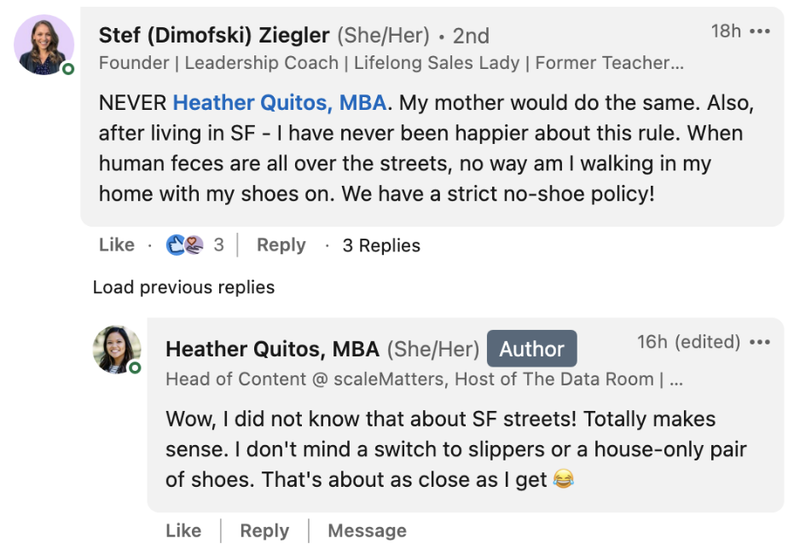
An example of a great response to a comment on an author’s LinkedIn post.
Key Takeaways:
- Issue: Ignoring comments reduces engagement.
- Solution: Respond early and thoughtfully to build relationships and boost the algorithm.
7. Sharing Content Without Adding Value
The seventh mistake CEOs make on LinkedIn is sharing content without adding value. This often happens with busy executives who have their team share blog posts or articles on their behalf. However, LinkedIn's algorithm favors original content over shared content. Simply sharing a post doesn't engage the audience effectively. For instance, sharing a video with a vague comment like "Entrepreneurship, okay, I'm not going to really watch this video" doesn't enhance the content or encourage interaction.
To make shared content work on LinkedIn, it's essential to add value by personalizing it and explaining why it matters. For example, Alex takes an idea and makes it his own, providing context and insight that makes the shared content more engaging and valuable to his audience. Another effective strategy is news hijacking, where you add your perspective to a trending article relevant to your industry. If you're one of the first to do this within the first 24 to 48 hours, you can gain significant visibility.
An even better approach is to offer a contrarian view. For example, if the New York Times publishes an op-ed relevant to your field, you can share it and explain why you disagree, backed by your 20 years of experience and personal stories. This not only adds depth to the conversation but also positions you as a thought leader with unique insights. While there are ways to share content effectively, the general recommendation is to focus on creating original content to maximize engagement and visibility on LinkedIn.

An example of a repost where little-to-no value is added to the original post.

An example of a repost where more value and personal perspective is added to the original content.
Key Takeaways:
- Issue: Shared content without personal input doesn’t perform well.
- Solution: Always add your perspective or commentary to shared posts.
8. Poorly Crafted Headlines
A common yet easily rectifiable mistake many executives make on LinkedIn is having a poor headline. This issue is surprisingly prevalent among otherwise qualified and credible leaders. For instance, a headline like "Gabrielle rappy. Pay is hiring" leaves viewers puzzled about what "rappy" is, while "Nicole? Speaker advocate igniter veteran" offers no clear indication of what Nicole does. These vague and unclear headlines fail to convey the executive’s value proposition and expertise.
In contrast, a well-crafted headline can make a significant difference. Take Logan Lyles, for example: "We produce B2B podcasts that drive revenue" clearly states what he does and the benefit he offers. Even polarizing additions like "Christ follower" can be effective if they resonate with a specific audience, attracting those who align with the values while repelling others. This strategy can help build a more engaged and relevant network.
Your LinkedIn headline is ubiquitous, appearing whenever you comment on posts or interact on the platform. Therefore, it’s crucial to be concise and clear about the value you bring. Effective examples include "Justin Welsh - Building a portfolio of one-person businesses to $5 million in revenue" or "Austin - I teach people how to land amazing jobs without applying online." These headlines quickly communicate expertise and value, making a lasting impression on potential connections and followers.
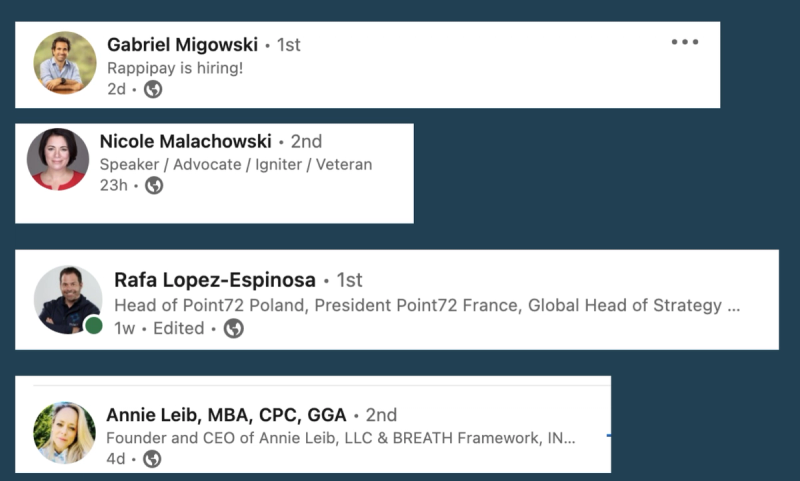
Examples of poor LinkedIn headlines. These examples provide little insight into what the person actually does, which is a missed opportunities in comments & posts.

Examples of good LinkedIn headlines. They provide more information about the executive and give context on WHY someone might want to engage with (or follow) them.
Key Takeaways:
- Issue: Generic or unclear headlines fail to attract attention.
- Solution: Create concise, descriptive headlines that clearly convey your value.
9. Ignoring Analytics
A common oversight among LinkedIn users is the failure to analyze the results of their efforts. While LinkedIn's built-in analytics are somewhat rudimentary, there is a more effective solution available. The Shield app, for instance, provides in-depth insights and metrics for a reasonable monthly fee, making it a valuable tool for those who post frequently. By leveraging such analytics, users can gain a clearer understanding of their content’s performance and make informed adjustments.
Justin Welsh's approach to content tracking offers a practical example of how analytics can be used effectively. He operates on the principle that after six months, content generally fades from memory. By tracking the performance of his posts over time, he can identify which ones resonated well with his audience. Successful posts are either tweaked or reposted six months later, while underperforming ones are discarded. This method ensures that his content remains relevant and engaging, constantly improving through a process akin to survival of the fittest.
Overall, the use of advanced analytics like those provided by Shield can significantly enhance the effectiveness of a LinkedIn strategy. By systematically reviewing and iterating on past content, users can cultivate a collection of high-performing posts that continually engage and grow their audience. This blend of art and science in content management helps maintain a dynamic and impactful LinkedIn presence.

An example of the advanced analytics available in a platform like ShieldApp.ai, a reasonably priced browser extension that significantly enhances LinkedIn’s data.
Key Takeaways:
- Issue: Not analyzing post performance hinders improvement.
- Solution: Use tools like Shield App to track and refine your content strategy.
10. Not Commenting on Others’ Posts
One of the critical mistakes CEOs make on LinkedIn is not commenting on other people's content. Commenting isn't just a minor engagement strategy; it's a substantial part of audience growth, contributing up to 40% according to some experts. Reciprocating comments is a fundamental strategy—engaging with those who engage with you helps build a supportive network. Another effective approach is "comment drafting," which involves being among the first to comment on posts by users with large followings. This can significantly boost visibility, sometimes leading to thousands of views and attracting new followers.
Moreover, commenting is excellent for relationship building. Consistently engaging with others' posts can make your name recognizable within your network, fostering connections and increasing your influence. For instance, when you frequently comment on someone's posts, they begin to recognize and remember you, which can open doors for further interaction and collaboration. This strategy is particularly beneficial for those looking to grow their network and enhance their presence on LinkedIn.
For those serious about leveraging this strategy, it often becomes a volume play. Successful users typically dedicate a set amount of time daily to skim through posts, add thoughtful comments, and move on quickly. This approach focuses more on growth than learning, prioritizing volume and consistency over in-depth engagement. While this may differ from a learning-focused approach, it proves highly effective for growing an audience and establishing a strong LinkedIn presence. Overall, active commenting is a powerful yet often underutilized strategy for executives looking to maximize their impact on LinkedIn.

Examples of generic comments that add little-to-no value to the conversation. These do not stand out, and are unlikely to drive further comments or people following these comments.

Examples of great comments, which expand on the original post. If a comment like this is used early enough on a post, it is likely to get significant attention and can drive more follows.
Key Takeaways:
- Issue: Lack of interaction limits network growth.
- Solution: Engage with others’ posts to build relationships and increase your visibility.
Honorable Mention
Before we move on, here are a couple of honorable mentions that can significantly enhance your LinkedIn strategy. First, always give people a reason to comment. Your posts should ideally spark ideas or ask questions to encourage engagement. Engagement is crucial as it helps increase your visibility and fosters a community around your content.
Additionally, don't become a one-hit-wonder. While it's great to write a popular post about a specific topic, you should diversify your content. Generally, it's advisable to focus on three to five topics. This approach allows you to establish expertise in multiple areas without confusing your audience. It ensures that you remain relevant and engaging over the long term.
Lastly, treat your LinkedIn profile as a sales funnel. This means optimizing it to guide visitors towards taking specific actions, whether that’s connecting with you, visiting your website, or contacting you for business opportunities. A well-organized profile that clearly communicates your value proposition can significantly enhance your professional presence on the platform.
Chapter 3: Mindset Notes for LinkedIn Success
In having helped over 200+ CEOs be active on LinkedIn, I’ve realized that often what holds back their success is not their skillset, but instead their mindset.
The following are the top tips I give our clients to prevent their mindset from sabotaging their success.
A: Embrace Discomfort
One key phrase I emphasize is "in service of." Many executives I meet are not interested in self-promotion or being in the spotlight. They post on LinkedIn more for their company’s benefit than their own. This discomfort with self-promotion can hinder their activity on the platform. To overcome this, I encourage them to see their LinkedIn activity as a service to their organization. By being visible and active, they can help their team with hiring, growth, and overall brand enhancement. This shift in perspective helps them embrace LinkedIn for the benefit of their company rather than personal gain.
Regarding the entry of AI into LinkedIn, there’s a lot of buzz and curiosity. Although I feel somewhat out of the loop on the latest AI developments, especially regarding its impact on content creation, I believe that genuine creativity will always hold a significant place. A thought-provoking video shared on LinkedIn featured Steve Jobs discussing how technology, like bicycles, enhances human capabilities without replacing the human element. This analogy applies to AI as well – it can enhance our efficiency but won’t replace the core human creativity and connection.
While AI-driven strategies might work for visibility, I believe they are short-lived when it comes to genuine business results. Content that resonates deeply with audiences tends to be born from authentic human creativity rather than generic AI-driven approaches. Therefore, while exploring AI’s potential, it’s crucial to maintain a focus on creating genuine, engaging content that reflects true human insight and creativity.
Key Takeaways:
- Concept: Being active on LinkedIn might feel uncomfortable, but it serves your organization.
- Tip: Frame your activity as being “in service of” your company.
B: Activate Your Network
A key mindset to adopt regarding your professional network is understanding the importance of visibility. Despite having attended great schools, worked with impressive colleagues, and built a high-power network, many professionals find that only a small fraction of their network knows what they do for a living. While the statistic is illustrative, not factual, it underscores the necessity of maintaining an active presence on LinkedIn to generate awareness about your professional activities.
Being active on LinkedIn helps keep you top of mind within your network. People generally want to help and refer opportunities to their connections, but they can only do so if they are aware of what you do. LinkedIn serves as a platform for this continuous visibility. For example, a college friend whom I hadn't spoken to in 20 years referred his CEO to me after seeing my activity on LinkedIn, leading to a new customer for my business. This instance highlights the latent potential within your network that can be activated through consistent LinkedIn engagement.
Key Takeaways:
- Concept: Most people in your network don’t know what you do.
- Tip: Regularly post content to keep your network informed and engaged.
C: Focus on Quality Engagement
In my view, the primary purpose of LinkedIn is to activate your existing network. While audience expansion and growing a following are also important, they play a secondary role for most users. For individuals with a smaller following, say two to three thousand connections, the initial focus should be on staying top of mind for those who already know, trust, and like you. This means that for the first six months to a year, the goal is to engage your current network rather than prioritizing audience growth.
For those with a larger following, such as Michael Quinn with hundreds of thousands of followers, audience growth takes on a more significant role. However, for most users, the key to LinkedIn success lies in consistent engagement with your existing connections. This can be achieved by not only posting original content but also actively commenting on others' posts. In fact, 40% of audience growth comes from commenting, while 60% comes from posting. If time constraints limit your ability to create original content, dedicating just five minutes a day to commenting on others' content can be a highly effective growth strategy.
Key Takeaways:
- Concept: Growth on LinkedIn is driven by meaningful interactions.
- Tip: Balance your time between creating original posts and commenting on others.
Conclusion
By avoiding these common mistakes and implementing the strategies outlined in this eBook, CEOs can significantly enhance their LinkedIn presence. Remember, LinkedIn is not just a platform for self-promotion but a powerful tool for building relationships, sharing knowledge, and ultimately supporting your company’s growth.
Subscribe for Executive Updates
Go from Leader to Thought Leader
Whether you want to attract new talent, raise capital, launch a product, or establish yourself as a thought leader, we give you the tools you need to make it happen. Let's turn your expertise into influence. Schedule a strategy call today!




